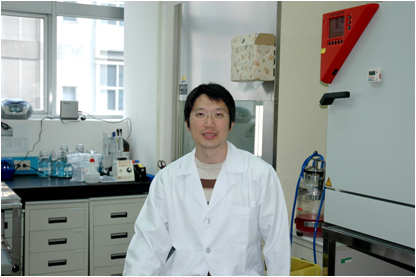劉慧康(Liu, Hui-Kang)
 Current position: Aassociate Research Fellow
Current position: Aassociate Research FellowE-mail: hk.liu@nricm.edu.tw
Education
Ph.D., Diabetes Research Group, Biomedical Sciences, University of Ulster Coleraine, UK (2003)
Major Professional Experiences
Postdoctoral Research Assistant in Molecular Physiology, University of Dundee, UK (2003~2005)
Specialty
Anti-Diabetes Research, Anti-Metabolic Syndrome Research, Cell Biology, Signal Transduction
Research Description
Diabetes is the disease leading to hyperglycemia, abnormal nutrient metabolism, and endocrine disorder because of insuliln deficiency and/or insulin resistance. In Taiwan, the prevalence of diabetes is 4.5% in 2003. On the other hand, metabolic syndrome can be regarded as risk factor for diabetes. Research focusing on the intervention of both subjects could bring substantial benefits towards public.
We have established several representative animal models for insulin-dependent diabetes and type 2 diabetes recently. In addition, various cell models related to the regulation of glucose homeostasis were also set up under our research laboratory. By employing those models, our intention is to generate an herbal based formula against diabetes and metabolic syndrome. In addition, we would like to validate historical anti-diabetes TCM formula by using the same system. The ultimate goal of this is to establish an effective therapeutic strategy for diabetes and to make some contribution of TCM globalization.
Published Papers
NCBI PubMed : Hui-Kang Liu (Please click!!)
-
Shie, F.-S., Shiao, Y.-J., Yeh, C.-W., Lin, C.-H., Tzeng, T.-T., Hsu, H.-C., . . . Liu, H.-K. (2015). Obesity and Hepatic Steatosis Are Associated with Elevated Serum Amyloid Beta in Metabolically Stressed APPswe/PS1dE9 Mice. PLoS One, 10(8). doi:10.1371/journal.pone.0134531
-
Huang, F.-L., Shiao, Y.-J., Hou, S.-J., Yang, C.-N., Chen, Y.-J., Lin, C.-H., . . . Tsay, H.-J. (2013). Cysteine-rich domain of scavenger receptor AI modulates the efficacy of surface targeting and mediates oligomeric Aβ internalization. Journal of Biomedical Science, 20:54. doi:10.1186/1423-0127-20-54
-
Tsay, H.-J., Huang, Y.-C., Huang, F.-L., Chen, C.-P., Tsai, Y.-C., Wang, Y.-H., . . . Shiao, Y.-J. (2013). Amyloid β peptide-mediated neurotoxicity is attenuated by the proliferating microglia more potently than by the quiescent phenotype. Journal of Biomedical Science, 20:78. doi:10.1186/1423-0127-20-78
-
Tzeng, T.-T., Tsay, H.-J., Chang, L., Hsu, C.-L., Lai, T.-H., Huang, F.-L., & Shiao, Y.-J. (2013). Caspase 3 involves in neuroplasticity, microglial activation and neurogenesis in the mice hippocampus after intracerebral injection of kainic acid. Journal of Biomedical Science, 20:90. doi:10.1186/1423-0127-20-90
-
Wang, C.-J., Chen, C.-C., Tsay, H.-J., Chiang, F.-Y., Wu, M.-F., & Shiao, Y.-J. (2013). Cudrania cochinchinensis attenuates amyloid β protein-mediated microglial activation and promotes glia-related clearance of amyloid β protein. Journal of Biomedical Science, 20:55. doi:10.1186/1423-0127-20-55
-
Lin, Y.-L., Tsay, H.-J., Liao, Y.-F., Wu, M.-F., Wang, C.-N., & Shiao, Y.-J. (2012). The Components of Flemingia macrophylla Attenuate Amyloid β-Protein Accumulation by Regulating Amyloid β-Protein Metabolic Pathway. Evidence-Based Complementary and Alternative Medicine. doi:10.1155/2012/795843
-
Shiao, Y.-J., Chen, W.-P., Kuo, Y.-C., & Lin, Y.-L. (2011). Phenylnaphthalenes and dihydronaphthalene derivatives from the roots of Vitex negudo. Journal of Chinese Medicine, 22(3-4), 153-159.
-
Yang, C.-N., Shiao, Y.-J., Shie, F.-S., Guo, B.-S., Chen, P.-H., Cho, C.-Y., . . . Tsay, H.-J. (2011). Mechanism mediating oligomeric Aβ clearance by naïve primary microglia. Neurobiology of Disease, 42(3), 221-230. doi:10.1016/j.nbd.2011.01.005
-
Huang, W.C., Yen, F.C., Shie, F.S., Pan, C.M. Shiao, Y.J., Yang, C.N. Huang, F.L. Sung, Y.J. Tsay, H.J. (2010) TGF-beta1 blockade of microglial chemotaxis toward Abeta aggregates involves SMAD signaling and down-regulation of CCL5. J. Neuroinflamm. 2010 7, 28.
-
Shiao, Y. J., W. P. Chen, Y. L. Lin. (2009) New polyphenols and triterpene from the pseudobulbs of Pleione formosana. J. Chin. Chem. Soc. 56, 828-833.
-
Huang, W.C., Yen, F.C., Shiao Y.J., Shie F.S., Chan J.L., Yang C.N., Sung Y.J., Huang F.L., Tsay H.J. (2009) Enlargement of A aggregates through chemokine- dependent microglial clustering Neurosci. Res. 63, 280-287.
-
Chi, C.W., Lin, Y.L. Chen, C.F., Wang C.N.* and Shiao Y.J.* (2008) “Tournefolic acdi B attenuates amyloid protein mediated toxicity by abrogating the calcium overload in mitochondria and retarding the caspase 8-truncated Bid-cytochrome c pathway in rat cortical neurons”Eur. J. Pharmacol. 586, 35-43.
-
Tsai,W.J., Shiao,Y.J., Lin, S.J., Chiou, W.F., Lin, L.C., Yang, T.S., Teng, C.M., Wu, T.S. and Yang, L.M. (2006)“Selective COX-2 inhibitors. Part 1: Synthesis and biological evaluation of phenylazobenzenesulfonamides” Bioorgan. Med. Chem. Lett. 16, 4440-4443.
-
Chen C.C., Shiao, Y.J., Lin, R.D., Shao, Y.Y., Lai, M.N. Lin, C.C., Ng,r, L.K. and Kuo, Y.H. (2006) “Neuroprotective Diterpenes from the Fruiting Body of Antrodia camphorata” J. Nat. Prod. 69, 689-691.
-
Wang, C.N., Pan, H.C., Lin, Y.L., Chi, C.W. and Shiao Y.J.* (2006)“Ester derivatives of tournefolic acid B attenuate N-Methyl-Daspartate-mediated excitotoxicity in rat cortical neurons” Mol. Pharmacol. 69, 950-959.
